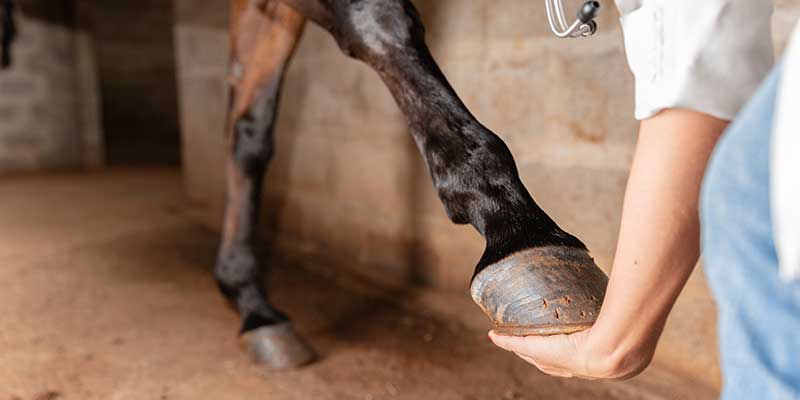As enthusiastic and dedicated equestrians, understanding how to treat cracked hoof on horse is crucial to maintaining the health and well-being of our beloved horses. Cracked hooves can cause significant discomfort and lead to serious health issues if not properly managed. In this article, we will delve into the symptoms, causes, and various treatments for cracked hooves, ensuring that you are well-equipped to handle this common but critical equine health issue.

Understanding Cracked Hooves
What Are Cracked Hooves?
Cracked hooves refer to splits or fissures in a horse’s hoof wall. These cracks can vary in length and depth, with some extending only superficially while others penetrate deeper into the hoof, causing pain and potential infection.
Common Symptoms
- Visible splits or fissures on the hoof wall
- Lameness or limping
- Swelling or heat in the affected area
- Reluctance to bear weight on the affected hoof

Causes of Cracked Hooves
Poor Nutrition
A diet lacking in essential nutrients such as biotin, methionine, and zinc can weaken the hoof structure, making it more prone to cracks.
Environmental Factors
Extreme weather conditions, such as excessive moisture or dryness, can compromise hoof integrity. For instance, prolonged exposure to muddy or wet environments can cause the hoof to soften and crack.
Inadequate Hoof Care
Improper hoof trimming and shoeing techniques can lead to uneven pressure distribution, contributing to the development of cracks.
:max_bytes(150000):strip_icc()/akhal-teke-2d3ee28a187749658a7dd3f35c522ab7.jpg)
Preventive Measures
Balanced Diet
Ensuring your horse’s diet is well-balanced with essential nutrients is fundamental. A diet rich in vitamins and minerals, specifically biotin, zinc, and methionine, will promote healthy hoof growth. You can read more about the importance of these nutrients here.
Regular Hoof Maintenance
Frequent and proper hoof trimming is crucial. A professional farrier should inspect and trim your horse’s hooves regularly to maintain their shape and balance.
Environment Management
Maintaining a stable environment with proper drainage will reduce the risk of hoof problems. In excessively dry conditions, providing a moist area or hoof moisturizers can prevent cracks.

Treatment Options for Cracked Hooves
Consulting a Farrier
One of the first steps in treating a cracked hoof is consulting a skilled farrier. They can assess the severity of the crack and implement corrective trimming or shoeing techniques to alleviate pressure on the affected area.
Hoof Supplements
Incorporating hoof supplements into your horse’s diet can expedite the healing process. These supplements often contain biotin, methionine, and other essential nutrients that foster hoof growth and strength.
Hoof Dressings and Topicals
Applying hoof dressings or topical treatments can help keep the hoof moisturized and protect it from external factors that may exacerbate the crack. However, it’s essential to use products specifically designed for horses to avoid potential adverse effects.
Advanced Treatments and Technologies
Shoe Inserts and Pads
Shoe inserts and pads can provide additional support to the hoof, distributing weight more evenly and reducing pressure on the cracked area. This can be particularly beneficial for severe cracks.
Hoof Boots
Hoof boots are another excellent option for protecting the hoof and providing added support during the healing process. They can shield the crack from further damage and minimize discomfort for your horse.
Modern Veterinary Treatments
In some cases, veterinarians may recommend more advanced treatments such as hoof casts or surgical interventions. These options are typically reserved for severe or chronic cases where conventional methods have proven ineffective.
Long-term Hoof Health
Continuous Monitoring
Maintaining long-term hoof health requires continuous monitoring and preventive care. Regular check-ups with your farrier and veterinarian will ensure that any potential issues are addressed promptly.
Lifestyle Adjustments
Implementing lifestyle adjustments, such as providing appropriate exercise and maintaining a clean environment, can significantly impact the overall health of your horse’s hooves.
Conclusion
Understanding how to treat cracked hoof on horse is an essential aspect of responsible equine care. By recognizing the symptoms, causes, and available treatments, you can ensure the well-being and comfort of your horse. With consistent care and attention, cracked hooves can be effectively managed, allowing your horse to thrive. For more details on proper equine care, visit our articles on bridling a horse or English bridling.
FAQ
What are the main causes of hoof cracks in horses?
Hoof cracks in horses can be caused by poor nutrition, environmental factors, and inadequate hoof care.
How can I prevent my horse’s hooves from cracking?
To prevent hoof cracks, ensure your horse has a balanced diet, regular hoof maintenance, and a stable environment with proper drainage.
When should I consult a veterinarian for my horse’s cracked hoof?
Consult a veterinarian if the crack is severe, causing lameness, or if conventional treatments are ineffective. Advanced treatments may be necessary in such cases.
As an Amazon Associate, I earn from qualifying purchases.